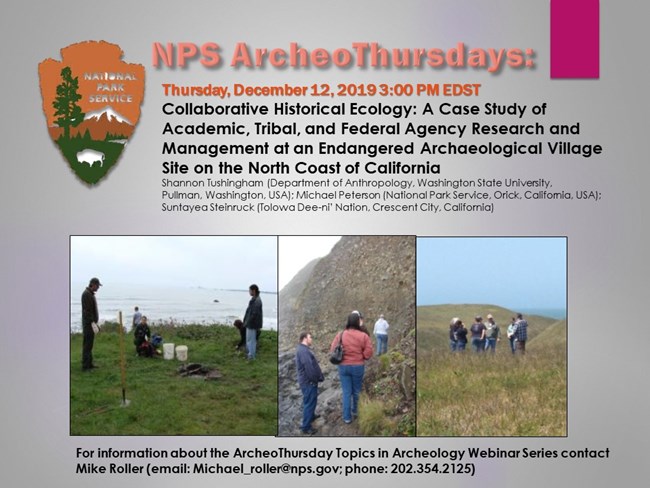Last updated: July 21, 2021
Article
Collaborative Historical Ecology: A Case Study of Academic, Tribal, and Federal Agency Research and Management at an Endangered Archaeological Village Site on the North Coast of California

Shannon Tushingham (Department of Anthropology, Washington State University, Pullman, Washington, USA); Michael Peterson (National Park Service, Orick, California, USA); Suntayea Steinruck (Tolowa Dee-ni’ Nation, Crescent City, California)
December 12th, 2019This webinar was presented as part of the National Park Service's ArcheoThursday Topics in Archeology Webinar series. The webinars are hosted by NPS archeologist Michael Roller.
Research at Shin-yvslh-sri (CADNO-14), a pre-contact Tolowa village and shell midden site on the north coast of California, involves an innovative collaborative historical ecology approach—an explicitly multi-disciplinary cooperative effort between Tribal communities, a Federal agency, cultural resource management practitioners, and academic researchers. In this webinar presentation, Shannon Tushingham (Washington State University), Suntayea Steinruck (Tolowa Dee-ni’ Nation), and Michael Peterson (NPS) will discuss their recent publication, “In the Footsteps of Amelia Brown: Collaborative Historical Ecology at Shin-yvslh-sri~, a Tolowa Village on the North Coast of California” and their multi-year efforts to better manage and document cultural resources threatened by impacts including coastal erosion, looting, illegal camping, and high visitation. To give a more complete picture of the historical ecology of the northern California coast, the authors used multiple lines of evidence—including ethno-historic, oral history, and Traditional Ecological Knowledge (TEK) data, documentation of past archaeological research, analysis of varied scales of (micro and macro) archaeological data from both recent fieldwork and legacy collections. Results indicate that plank house village life emerged at Shin-yvslh-sri∼ approximately 1,000 years ago, and that people pursued a wide array of marine and terrestrial taxa throughout its occupation. Important information was retrieved from a salvage context, with archaeological data providing new evidence, as well as support for oral histories indicating the critical importance of mass captured smelt, as well as salmon, shellfish, and marine mammals. In addition to providing important data on coastal human-environmental systems, the project provides a case study model for future studies in collaborative historical ecology, particularly those that involve indigenous community concerns at endangered coastal archaeological and cultural sites.
Visit our keyboard shortcuts docs for details
- Duration:
- 1 hour, 31 minutes, 39 seconds
Tushingham et al., 12/12/2019
